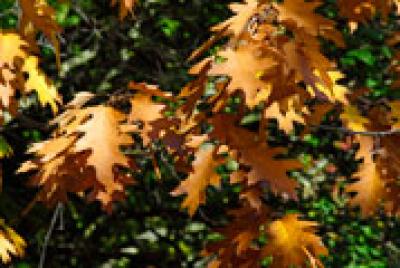Research suggests autumn is ending later in the northern hemisphere

This is a photo of autumn leaves. Credit: University of Southampton
A team of researchers examined satellite imagery covering the northern hemisphere over a 25 year period (1982 – 2006), and looked for any seasonal changes in vegetation by making a measure of its 'greenness'. They examined in detail, at daily intervals, the growth cycle of the vegetation – identifying physical changes such as leaf cover, colour and growth.
The project was led by University of Southampton Professor of Geography Peter Atkinson, who worked with his colleague Dr Jadunandan Dash and in collaboration with Professor Jeganathan Chockalingam from the Department of Remote Sensing at the Birla Institute of Technology in India.
Professor Atkinson says: “There is much speculation about whether our seasons are changing and if so, whether this is linked to climate change. Our study is another significant piece in the puzzle, which may ultimately answer this question.”
The team was able to examine the data for specific vegetation types: 'mosaic' vegetation (grassland, shrubland, forest and cropland); broad-leaved deciduous forest; needle-leaved evergreen forest; needle-leaved deciduous and evergreen forest; mixed broad-leaved and needle-leaved forest; and mixed-forest, shrubland and grassland. They analysed data across all the groups, recognising that forests which have not changed size due to human intervention, for example through forestry or farming, provide the most reliable information on vegetation response to changes in our climate.
The most pronounced change found by the researchers was in the broad-leaved deciduous and needleleaved deciduous forest groups, showing that Autumn is becoming significantly later. This delay in the signs of Autumn was generally more pronounced than any evidence for an earlier onset of Spring, although there is evidence across the groups that Spring is arriving slightly earlier.
Professor Peter Atkinson comments: “Previous studies have reported trends in the start of Spring and end of Autumn, but we have studied a longer time period and controlled for forest loss and vegetation type, making our study more rigorous and with a greater degree of accuracy.
“Our research shows that even when we control for land cover changes across the globe a changing climate is significantly altering the vegetation growth cycles for certain types of vegetation. Such changes may have consequences for the sustainability of the plants themselves, as well as species which depend on them, and ultimately the climate through changes to the carbon cycle.”
The study used the Global Inventory Modelling and Mapping Studies (GIMMS) dataset and combined satellite imagery with an innovative data processing method to study vegetation cycles.
The paper Remotely sensed trends in the phenology of northern high latitude terrestrial vegetation, controlling for land cover change and vegetation type is published in the journal Remote Sensing of the Environment and can be found at: http://www.sciencedirect.com/science/article/pii/S0034425713004422
Media Contact
More Information:
http://www.soton.ac.ukAll latest news from the category: Earth Sciences
Earth Sciences (also referred to as Geosciences), which deals with basic issues surrounding our planet, plays a vital role in the area of energy and raw materials supply.
Earth Sciences comprises subjects such as geology, geography, geological informatics, paleontology, mineralogy, petrography, crystallography, geophysics, geodesy, glaciology, cartography, photogrammetry, meteorology and seismology, early-warning systems, earthquake research and polar research.
Newest articles

“Nanostitches” enable lighter and tougher composite materials
In research that may lead to next-generation airplanes and spacecraft, MIT engineers used carbon nanotubes to prevent cracking in multilayered composites. To save on fuel and reduce aircraft emissions, engineers…

Trash to treasure
Researchers turn metal waste into catalyst for hydrogen. Scientists have found a way to transform metal waste into a highly efficient catalyst to make hydrogen from water, a discovery that…

Real-time detection of infectious disease viruses
… by searching for molecular fingerprinting. A research team consisting of Professor Kyoung-Duck Park and Taeyoung Moon and Huitae Joo, PhD candidates, from the Department of Physics at Pohang University…




















